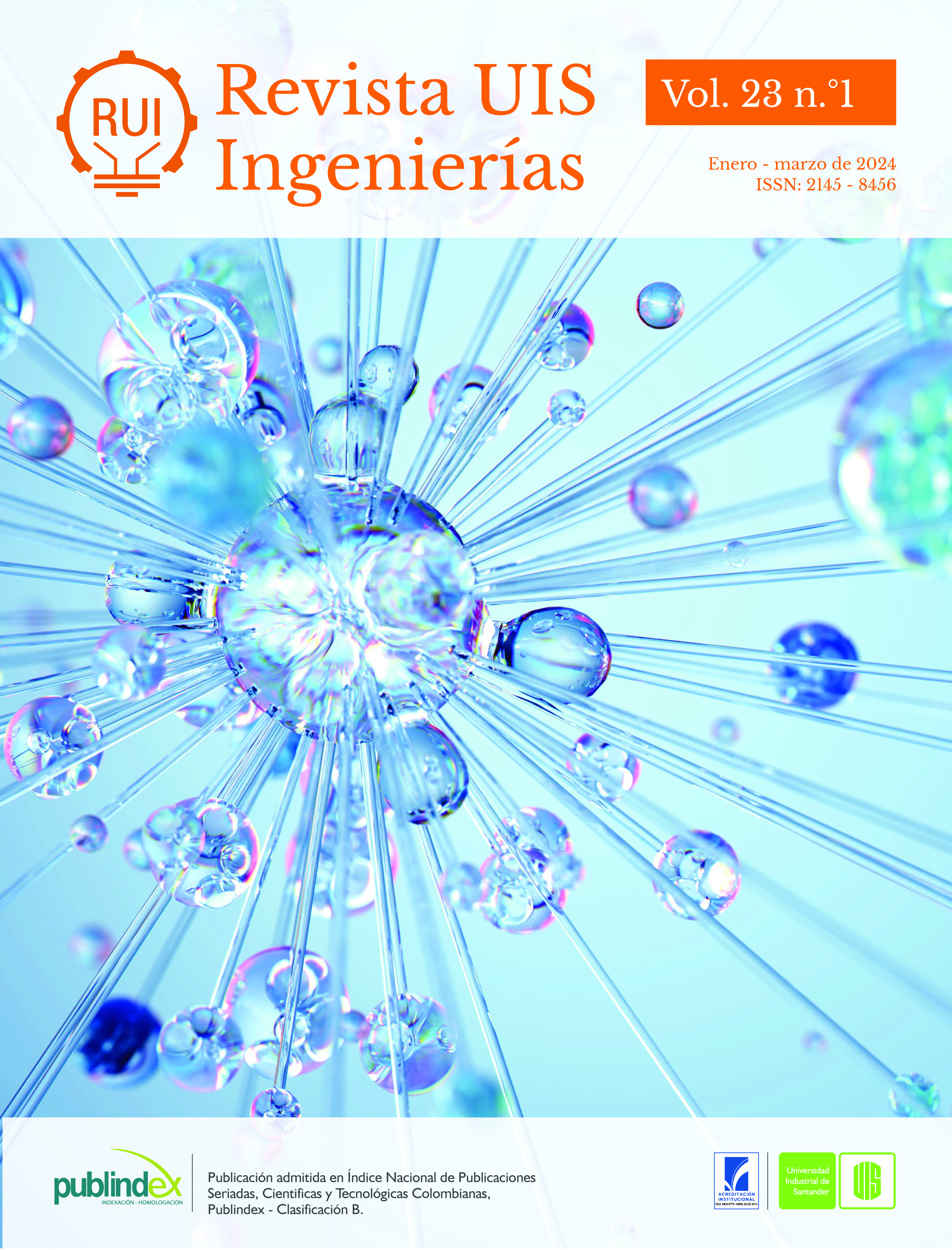Experimental study on the mechanical behavior of buried pipelines subjected to thermal load cycles
Published 2024-04-12
Keywords
- experimental study,
- piping stress analysis,
- mechanical behavior,
- thermal loads,
- finite elements
- buried pipes,
- soil mechanics,
- geotechnical engineering,
- petroleum engineering,
- numerical modeling ...More
How to Cite
Copyright (c) 2024 Revista UIS Ingenierías

This work is licensed under a Creative Commons Attribution-NoDerivatives 4.0 International License.
Abstract
En este trabajo se presenta un estudio experimental sobre el comportamiento mecánico de tuberías enterradas sometidas a ciclos de carga térmica. En primer lugar, se miden los esfuerzos y las deformaciones de manera experimental sobre una tubería enterrada sometida a cargas térmicas monotónicas y cíclicas, reproduciendo de esta manera las condiciones típicas de operación de sistemas de tubería enterrados. Posteriormente, se elabora un modelo numérico usando el método de los elementos finitos, el cual se validó utilizando los resultados obtenidos experimentales. A continuación, este modelo computacional se utilizó para llevar a cabo un estudio paramétrico de la influencia de las propiedades mecánicas del suelo sobre en el estado de esfuerzos del sistema. Finalmente, a partir de los resultados tanto experimentales como numéricos se concluyó que el caso más crítico para la tubería enterrada corresponde al primer ciclo de carga térmica y que las demás variables estudiadas tienen poco impacto.
Downloads
References
- R. Saadeldin, Y. Hu, A. Henni, “Numerical analysis of buried pipes under field geo-environmental conditions,” International Journal of Geo-Engineering, vol. 6, no. 1, p. 1-22, 2015, doi: https://doi.org/10.1186/s40703-015-0005-4
- D. Wijewickreme, “Role of geotechnical engineering in assuring the integrity of buried pipeline systems,” International conference on sustainable built environments. Kandy, Sri Lanka, 2012.
- M. M. Shahzamanian, M. Kainat, N. Yoosef-Ghodsi, S. Adeeb, “Systematic literature review of the application of extended finite element method in failure prediction of pipelines,” Journal of Pipeline Science and Engineering, vol. 1, no. 2, pp. 241-251, 2021, doi: https://doi.org/10.1016/j.jpse.2021.02.003
- J. Zhang, R. Xie, T. Zheng, G. Lu, J. Y. Xu, “Buckling behavior of buried pipe crossing stratum subsidence area”, Engineering Failure Analysis, vol. 135, 106130, 2022, doi: https://doi.org/10.1016/j.engfailanal.2022.106130
- American Society of Mechanical Engineers. ASME B 31.4. Pipeline Transportation Systems for Liquid Hydrocarbons and Other Liquids. 2013.
- American Society of Mechanical Engineers. ASME B 31.8. Gas Transmission and Distribution Piping Systems. 2013.
- L. Peng, “Stress analysis methods for underground pipe lines. Part 2,” Pipe Line Industry, pp. 65-75, 1978.
- L. Peng, “Stress Analysis Methods for Underground Pipe Lines. Part 1,” Pipe Line Industry, pp. 67-71, 1978.
- P. F. Liu, J. Y. Zheng, B. J. Zhang, P. Shi, “Failure analysis of natural gas buried X65 steel pipeline under deflection load using finite element method,” Materials and Design, vol. 31, no. 3, pp. 1384-1391, 2010, doi: https://doi.org/10.1016/j.matdes.2009.08.04
- Y. Friedmann, “Some Aspects of the Design of Hot Buried Pipelines,” in Offshore Oil and Gas Pipe Line Technology Conference, Paris, France, 1986.
- C. P. K. Gallage, J. Kodikara, D. Chan, “Response of a plastic pipe buried in expansive clay,” Proceedings of the Institution of Civil Engineers-Geotechnical Engineering, vol. 165, no. 1, pp. 45–57, 2011, doi: https://doi.org/10.1680/geng.9.00037
- Y. Hu, H. Q. Vu, “Analysis of soil conditions and pipe behaviour at a field site,” Canadian Geotechnical Journal, vol. 48, no. 6, pp. 847-866, 2011, doi: https://doi.org/10.1139/t11-010
- G. Kruisman, K. W. Radder, “Influence of the soil in advanced buried pipe line analysis,” in Offshore Oil and Gas Pipe Line Technology Conference, Ostend, 1990.
- Y. Friedmann, B. Debouvry, “Analytical design method helps prevent buried pipe upheaval,” Pipe Line Industry, pp. 23-27, 1992.
- N. J. R. Nielsen, B. Lyngberg, P. T. Pedersen, “Upheaval buckling failures of insulated buried pipelines: A case story,” in Offshore Technology Conference, Houston, Texas, paper OTC-6488-MS, 1990, doi: https://doi.org/10.4043/6488-MS
- P. E. L. Schaminee; N. F. Zorn; G. J. M. Schotman, “Soil response for pipeline upheaval buckling analyses: Full-scale laboratory tests and modelling,” in Offshore Technology Conference, Houston, Texas, paper OTC-6486-MS, 1990, doi: https://doi.org/10.4043/6486-MS
- J. A. Villarraga, J. F. Rodrı́guez, C. Martı́nez, “Buried pipe modeling with initial imperfections,” Journal of Pressure Vessel Technology, vol. 126, no. 2, pp. 250-257, 2004, doi: https://doi.org/10.1115/1.1688369
- FLOWTITE, “Installation Guide for Buried Pipes – AWWA,” 2016. [Online]. Available: https://www.flowtite.com/wp-content/uploads/1901_Flowtite-Installation-Guide-Buried-Pipes_web.pdf.
- American Society of Testing Materials. ASTM E 8M. Standard Test Methods for Tension Testing of Metallic Materials. 2004.
- W. F. Chen, Ed., “Chapter 1 - Introduction,” in Developments in Geotechnical Engineering, vol. 7, Supplement C vols., Elsevier, 1975, pp. 1–14.
- R. Colasanti, J. Hovarth, “Practical subgrade model for improved soil-structure interaction analysis: Software implementation,” Practice periodical on structural design and construction, vol. 15, no. 4, 2010, doi: https://doi.org/10.1061/(ASCE)SC.1943-5576.0000060
- R. Goncalves, Introducción al Análisis de Esfuerzos. Caracas: Editorial Equinoccio, 2011.
- L. Espinoza, O.A. González-Estrada, C. Graciano, “Análisis de un interno tipo brida de un recipiente horizontal a presión utilizando elementos finitos”, Revista UIS Ingenierías, vol. 18, no. 3, pp. 151-156, 2019, doi: https://doi.org/10.18273/revuin.v18n3-2019015
- E. Araque, C. Graciano, D.G. Zapata-Medina, O.A. González-Estrada, “Compressive strength of partially stiffened cylinders at elevated temperatures,” Revista UIS Ingenierías, vol. 19, no. 1, pp. 131-142, 2020, doi: https://doi.org/10.18273/revuin.v19n1-2020013
- C. Graciano, E. Casanova. “Modelado numérico del proceso de izado de un cabezal hemisférico de un regenerador,” Revista UIS Ingenierías, vol. 21, no. 3, pp. 101-110, 2022, doi: https://doi.org/10.18273/revuin.v21n3-2022009
- ANSYS, “ANSYS Release 19R2 Elements Reference”, 2019.
- T. W. Lambe, R. V. Whitman, Soil Mechanics Si Version. Wiley India Pvt. Limited, 2008.
- P. Hudak, B. Sadler, B. Hunter, “Analyzing underground water-pipe breaks in residual soils,” Water Engineering Management, vol. 145, pp. 15–20, 2000.

